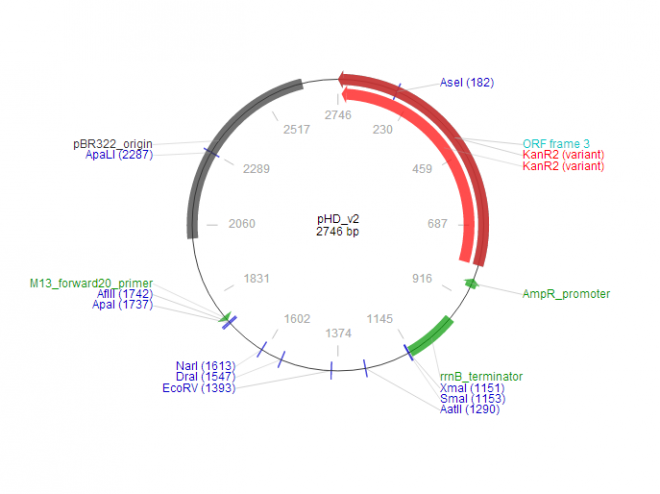pHD_v2 载体
| 质粒类型: | Tale ToolBox kit |
|---|---|
| 高拷贝/低拷贝: | 高拷贝 |
| 克隆方法: | 多克隆位点,限制性内切酶 |
| 载体大小: | 2746 bp (查看载体序列) |
| 载体抗性: | Kanamycin (卡那霉素) |
(a) Natural structure of TALEs derived from Xanthomonas sp. Each DNA-binding module consists of 34 amino acids, where the RVDs in the 12th and 13th amino acid positions of each repeat specify the DNA base being targeted according to the cipher NG = T, HD = C, NI = A, and NN = G or A. The DNA-binding modules are flanked by nonrepetitive N and C termini, which carry the translocation, nuclear localization (NLS) and transcription activation (AD) domains. A cryptic signal within the N terminus specifies a thymine as the first base of the target site.
(b) The TALE toolbox allows rapid and inexpensive construction of custom TALE-TFs and TALENs. The kit consists of 12 plasmids in total: four monomer plasmids to be used as templates for PCR amplification, four TALE-TF and four TALEN cloning backbones corresponding to four different bases targeted by the 0.5 repeat. CMV, cytomegalovirus promoter; N term, nonrepetitive N terminus from the Hax3 TALE; C term, nonrepetitive C terminus from the Hax3 TALE; BsaI, type IIs restriction sites used for the insertion of custom TALE DNA-binding domains; ccdB + CmR, negative selection cassette containing the ccdB negative selection gene and chloramphenicol resistance gene; NLS, nuclear localization signal; VP64, synthetic transcriptional activator derived from VP16 protein of herpes simplex virus; 2A, 2A self-cleavage linker; EGFP, enhanced green fluorescent protein; polyA signal, polyadenylation signal; FokI, catalytic domain from the FokI endonuclease.
(c) TALEs can be used to generate custom TALE-TFs and modulate the transcription of endogenous genes from the genome. The TALE DNA-binding domain is fused to the synthetic VP64 transcriptional activator, which recruits RNA polymerase and other factors needed to initiate transcription.
(d) TALENs can be used to generate site-specific double-strand breaks to facilitate genome editing through nonhomologous repair or homology directed repair. Two TALENs target a pair of binding sites flanking a 16-bp spacer. The left and right TALENs recognize the top and bottom strands of the target sites, respectively. Each TALE DNA-binding domain is fused to the catalytic domain of FokI endonuclease; when FokI dimerizes, it cuts the DNA in the region between the left and right TALEN-binding sites.


